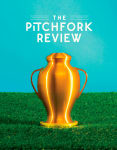When Pitchfork launched in 1996, Internet music criticism (or Internet anything) was virtually non-existent, and Pitchfork.com grew into arguably the most influential brand in online music coverage. Now, as many print music magazines shutter or go web-only, Pitchfork is returning to the roots of its trade: on December 14, the company will debut The Pitchfork Review, a quarterly print journal focused on longform music writing and design-focused content.
“There’s a lot of potential to rethink what people want out of a music magazine,” says Pitchfork founder and CEO Ryan Schreiber. “The tide has really shifted since we started Pitchfork in the mid-’90s. Then, there was no music criticism online; now, there’s very little in print. There’s all kinds of talk about how physical media is dying, but the popularity of vinyl is rising, and there has been a rise in literary and culture publications. It’s not dead, it just needs substance.”

The Pitchfork Review is not going after the casual newsstand browser. Printed on high-quality paper stock and more like a series of books, it will available at thepitchforkreview.com for an annual subscription rate of $44.99 if ordered prior to Dec. 15 ($49.99 after Dec. 15). Single copies will be available for $19.96, in a nod to Pitchfork’s founding year. Select booksellers and newsstands will also carry the publication.
“The price point is in line with the literary and cultural journals that exist, like Monocle and Kinfolk,” says Schreiber. “It will be substantial, printed on quality stock. With vinyl you’re paying more than a download, but it’s permanent and substantial.”
In a move that for now eliminates one of print media’s biggest business challenges—selling pages to advertisers—Pitchfork secured Converse as the Review’s exclusive advertising partner for the first four issues through 2014. The activation will include a 7-inch series of exclusive tracks, some recorded at Converse’s Rubber Tracks studio in Brooklyn, where Pitchfork will also host a launch event on Dec. 14.

According to Schreiber, The Pitchfork Review will have a heavy focus on design and photography that is more difficult to execute on the web, and the first issue’s preview pages (featured in the slideshow above) certainly demonstrate a more classic aesthetic than Pitchfork’s digital sites. While the publication will include select content from Pitchfork.com, most of the features will be exclusive to the print product and be more in-depth and evergreen.
“We’ve enlisted seasoned writers who have experience in longform and narrative,” says Schrieber. “Magazines have lost their foothold on breaking news, so the original content in the Review is new but less time sensitive. It looks at current music but also catalog artists.” The first issue includes pieces about Van Morrison, Otis Redding, a career-spanning piece on Glenn Danzig, and a feature on the history of the jukebox. There is also a retrospective on the glory days of the U.K. weekly music press by veteran English critic Simon Reynolds. The Review “works in a more relaxed and engaged mode,” says Schreiber. “There are distractions on the web; there’s a different mentality on sitting down with a book.”
Schreiber says that Pitchfork is counting on serious music fans’ hunger for in-depth content to sell copies and subscriptions, rather than cover artists. In fact, none of the planned covers feature artists, but are rather focused on concept or design. According to Schreiber, The Pitchfork Review will take a different approach from, for example, the last iteration of SPIN magazine’s print product–a semi-monthly printed on heavy stock with in-depth features and photography aimed at a collector’s mindset–which was discontinued less than a year after launch.
“They kind of had the right idea, but it was still about everything being new and first. You were seeing a lot of the same things that had already been out there, the same artists that you’re seeing every day,” says Schreiber. “We’re not trying to be what music publications have traditionally been. We’re trying to break free from this constant racing to be first, which we do online.”
Recognize your brand’s excellence by applying to this year’s Brands That Matter Awards before the early-rate deadline, May 3.










